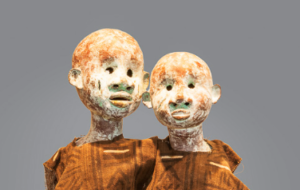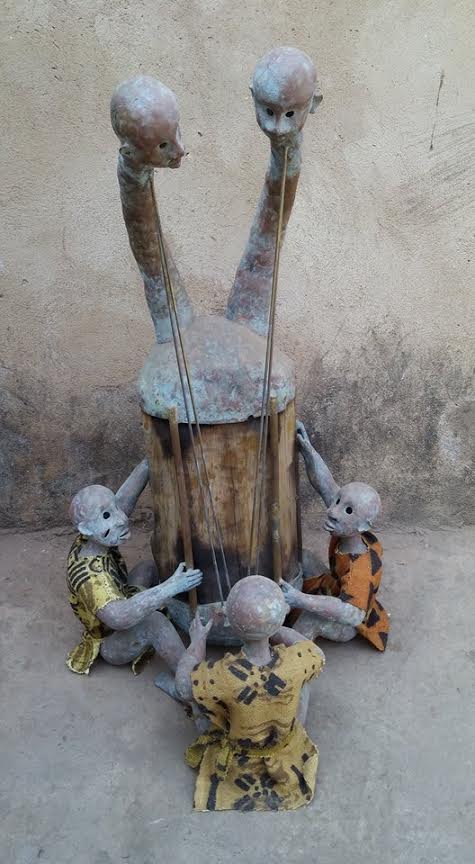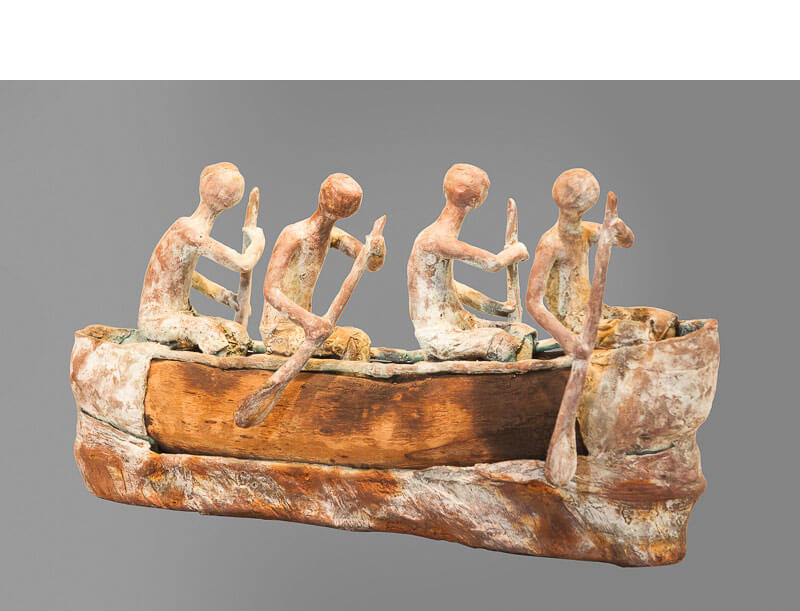
Recent works by Boukaré Bonkoungou: Gallery 23, February 5 until 20 February, 2017, KNSM-Laan, Amsterdam
EMOTIONALLY CHARGED SCULPTURES
It is no surprise that Boukaré Bonkoungou (1978) works with bronze. Burkina Faso has a long tradition of casting in bronze. Passed from father to son. As was the case in his own family. Some of his skill was therefore handed down, however he also studied at the CNAA, the ‘National Center for the Arts and Crafts’ in Ouagadougou. An institute that has provided many artists with their first steps on the professional ladder (Papa Adama, for example, who lives and works in the Netherlands).

Lunai.
The small bronze sculptures they make there are often intended for tourists. They thus also keep to the visual language that appeals to these tourists. Skillfully made, but interchangeable with regard to form and content. Elegant, often dancing female figures for instance. Bonkoungou distances himself completely from this genre. As the sculptures in this exhibition clearly prove.

Diplomatico cocodrilo, 2015.
First of all he does not confine himself to bronze. In his sculptures he combines wood with bronze and sometimes also with iron. The wood is not always visible since it lies concealed beneath elementary clothing made from traditional, coarse Bogolan fabrics. This combination of materials deprives the bronze of its inherent coldness and detachment, which is replaced by vulnerability and tactility.
Nor do his themes follow the standard path. Although he does also make (large) animal sculptures such as the rhino and the warthog, he is still mainly concerned with people, ordinary people, solitary individuals but often also people who have something in common (schoolchildren, travelers, diplomats, refugees) or who have a relationship with each other (parent-child, man-woman).

A good example of this is the table sculpture ‘Sinistre’ of ten refugees who, with dilapidated or shabby suitcases, disoriented, agitated (brandishing arms) appear to be on their way to an uncertain and doubtful destination. Although Bonkoungou’s execution of the peoples’ heads is elementary – hairless, round heads with holes for eyes – he manages to make the scene emotional. He partly does this through the gestures and postures of the refugees, and partly by making the bronze look worn and by using old wood thereby suiting the materials to the tattered and impoverished character of the group.
While in general the sculptures are quite realistic, some works have been given a surrealistic twist. My impression is that he does this when he wants to add an extra symbolic meaning. There is one sculpture for instance, ‘Transmission de savoir’, where three child figures are sitting on a tree stump.

Transmission de savoir, 2015.
From this stump two long necks stick out which end in two heads that are looking down. Strings come out of these long necks and connect with the lively group of children. The general theme is the parent-child relationship, but the twist opens the work up for further elucidation, makes it more thought provoking.

Les Aventuriers, 2015.
The person setting up an exhibition usually has some influence on the perception of works of art. The exhibition space likewise helps to determine how the viewer experiences a work of art. Bonkoungou appears to allow the arranger an even greater freedom. I saw a number of his human figure sculptures just as they were being unpacked from a couple of transport crates. All individual items of about the same size. They stood together in random small groups. They had been taken one at a time from the various boxes or crates. These small groups however began to lead a life of their own. Unintentionally they began to form mutual relationships. I had no trouble at all inventing a narrative for them in which they could play, or had played a role. It is therefore possible that in the final layout they will tell a different story, simply because their presentation, their grouping, has been changed.
Thereby proving that the artist, despite the possibly somewhat disengaged basic material he uses and despite the abstract way in which he gives form to his figures, succeeds in providing them with recognizable emotions.
This makes you an exceptional artist.
